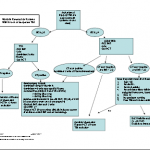One of the more commonplace recommendations for recovery from mild traumatic brain injury (TBI) is “cognitive rest.” Sports medicine professionals recommend it, physiatrists recommend it, and trauma professionals talk about it.
First, what is it, exactly? I’ve seen a number of descriptions, and they vary quite a bit. The main concept is to avoid all activities that involve mental exertion. This includes using a computer, watching TV, talking on a cell phone, reading, playing video games, and listening to loud music. Huh?
What good does this allegedly do? Most articles that I’ve read theorize that cognitive activity somehow increases the metabolic activity of the brain and that this is bad. One of the more interesting papers I read (from 2010!) says it best: “It is now well-accepted that excessive neurometabolic activity can interfere with recovery from a concussion and that physical rest is needed.”
Read carefully. Well-accepted. The paper cites unpublished data on children by one of the authors, 2 meta-analyses and 2 consensus opinions. In other words, no data at all. Yet somehow the concept has caught on.
First of all, I don’t think it’s possible for most people to realistically practice cognitive rest. Who knows if there is really any difference in metabolism and energy use by the brain if you are engaging in any of the banned activities above? And let’s go to the other extreme: if one lies quietly in bed meditating, shouldn’t this be the ultimate cognitive rest? Yet fMRI and PET studies suggest (also limited data) that cerebral flow in specific areas of the brain increases during this state.
Maybe a modest increase in activity is good. Physical activity (within limits) has been shown to be very beneficial to physical and psychological well being time and time again. And the only paper I could find on the topic with respect to TBI showed that randomization to bedrest vs normal physical activity had no difference in post-concussive syndrome incidence or severity. However, the active group recovered with significantly less dizziness.
Bottom line: There is no data to support the concept of cognitive rest. Any type of activity, either mental or physical, can cause fatigue in a variable amount of time in people with mild TBI. It is probably best to interpret this as a signal to take it easy and recover for a while before exerting oneself again. But so far there is no objective data to show that cognitive activity either helps or hinders recovery.
References:
- Cognitive rest: the often neglected aspect of concussion management. Athletic Therapy Today, March 2010, pg 1-3.
- Effectiveness of bed rest after mild traumatic brain injury: a randomised trial of no versus six days of bed rest. J Neurol Neurosurg Psychiatry 73:167-172, 2002.



